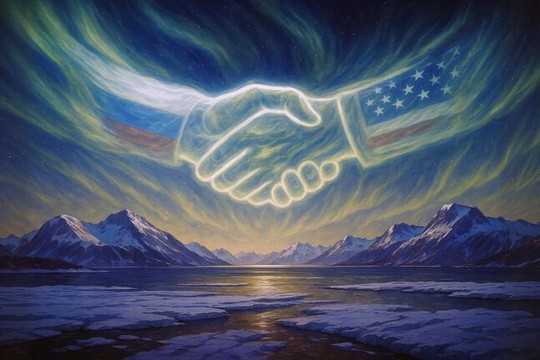Pic.: AI from publics
If you read the headlines in American and European newspapers you would conclude that the Alaska Summit failed.
It did not. Washington changed direction and abandoned its support for a ceasefire, stresses Stephen Bryen, a former U.S. Deputy Under Secretary of Defense.
Here is Mr. Trump's official statement:
“A great and very successful day in Alaska! The meeting with President Vladimir Putin of Russia went very well, as did a late night phone call with Zelenskyy of Ukraine, and various European Leaders, including the highly respected Secretary General of NATO. It was determined by all that the best way to end the horrific war between Russia and Ukraine is to go directly to a Peace Agreement, which would end the war, and not a mere Ceasefire Agreement, which often times do not hold up. Zelenskyy will be coming to D.C., the Oval Office, on Monday afternoon. If all works out, we will then schedule a meeting with President Putin. Potentially, millions of people’s lives will be saved.”
The major outcome of the Summit was that the push for a ceasefire agreement, a non-starter for the Russian side, has been taken off the table. This will come as a big shock for Zelensky and Europe. President Trump will have to figure out what to do next. He could go back to trying to squeeze the Russians with more sanctions or other punishments. But that would require yet another reversal and won't achieve anything.
The foreign policy crowd has been betting that the Russian economy is so bad that the whole Russian enterprise might collapse if the west jacks up the pressure on Russia.
Even under dire circumstances, after the fall of the Soviet Union and the collapse of the ruble, with massive unemployment, shut down factories, and crazy inflation, Yeltsin, then president, found a way forward, and Russia did not have a civil war and government institutions started to restore their authority. Yeltsin's administration lasted eight years and was replaced by a more conservative leader, Vladimir Putin.
One of the asymmetries of the Ukraine conflict is the political impact of Ukrainian drone and missile strikes on Russian territory. These attacks presumably are designed to answer Russia's relentless aerial strikes on Ukraine's critical infrastructure, on military targets, and in limited cases on civilian targets. But the other side of the coin is the impact of Ukraine's drone and missile strikes in garnering public support for the Russian "Special Military Operation" in Ukraine. Ukraine's attacks reinforce public opinion in favor of the SMO.
It is noteworthy, as illustrated by a recent Gallup poll in Ukraine, that despite the SMO and Russian drone and missile strikes, public opinion in Ukraine is turning decisively against continuing the war without a political settlement. Young men and women, in large numbers, are leaving Ukraine to escape the war and military conscription.
According to the London ‘Telegraph’, at least 650,000 Ukrainian men of fighting age have fled the country since the conflict with Russia escalated in 2022. This number does not include the thousands who currently are hiding from the authorities or paying bribes to stay out of the Ukrainian army.
Zelensky hews to a tough no compromises line on any settlement with Russia. He rejects any territorial deal. So when he bargains with Washington, he likely will do two things: try and get his supporters here in Washington to back up his position on no territorial concessions; and attempt to refocus Trump on providing security guarantees for Ukraine, demanding a Russian withdrawal from Ukrainian territory. He will most certainly ask Trump for more weapons and money, and for heavy sanctions on Russia. It isn't clear how Trump will respond.
The bottom line is, at least for now, US policy has shifted. The US and Trump no longer support a ceasefire but want to settle the Ukraine war through negotiations. How long that will take, and even if it is possible, remains to be seen. Meanwhile the war continues and, for the most part, Russia will continue pushing to take Pokrovsk and to expand the contact line further to the west. Ukraine, already stretched and now with uncertainties on military supplies, is facing a crisis.
read more in our Telegram-channel https://t.me/The_International_Affairs

 12:10 19.08.2025 •
12:10 19.08.2025 •























